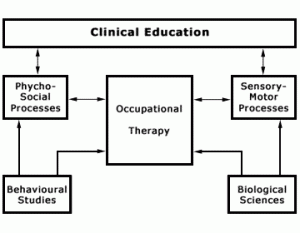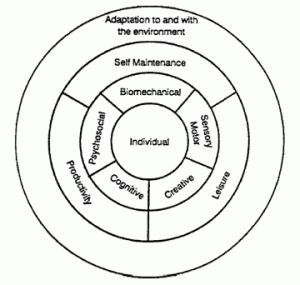BACKGROUND INFORMATION
Undergraduate occupational therapy curriculum documents within the School of Occupational Therapy, The University of Sydney dating from 1975 to 1995 confirm the link between the structure of curriculum content and contemporary occupational therapy practice. Prior to 1975, the primary mode of practice in occupational therapy in NSW was hospital-based therapy within the Department of Health (Alexander, Keogh & Cheesman, 1980). Curriculum documents describe occupational therapy content that was largely categorised according to perceived domains of practice within the health system for groups of clients as classified by medicine; for example, orthopaedics, neurology, paediatrics, psychiatry, rehabilitation and general medicine. Occupational therapy subjects, heavily influenced by concepts of rehabilitation, focussed on occupational therapy in neurology, occupational therapy in psychiatry and occupational therapy in orthopaedics and general medicine (School of Occupational Therapy, 1975). Definitions of occupations related to disability and definitions of occupational therapy focussed on provision of services to “individuals or groups whose abilities to cope with activities of daily living were threatened or impaired by …disability” (School of Occupational Therapy, 1975, p.2).
In 1975, attempts were made by curriculum developers to move away from using medical models to classify occupational therapy curriculum content in response to increasing specialisation in occupational therapy and prevailing notions of community practice. Subject areas within the curriculum reflected the major specialty practice domains. Subjects such as Sensory Motor Processes, Psychosocial Processes and Occupational Therapy became foundation subjects within the curriculum. This reflected the beginnings of a conceptual approach to curriculum design whereby occupational therapy practice was described as being composed of core knowledge and skills (Occupational Therapy), specialist knowledge and skills (Sensory Motor and Psychosocial Processes), and foundation knowledge (Biological Sciences and Behavioural Sciences)
Figure 1: Interrelation of major subjects within the curriculum framework (Occupational Therapy Stage 3 Submission, 1975, p.12).
The aim of this curriculum structure was to allow students to focus on the sensory motor and psychosocial processes that were viewed as underpinning occupational therapy practice, and to study the effects of disability on functional performance (School of Occupational Therapy, 1986). However, this way of dividing knowledge and skills within the curriculum, over time, reinforced divisions in the cognitive structure of student learning between the psychological, physical and functional aspects of human performance. Ultimately, there existed a dichotomy between what was perceived by students as sensory motor occupational therapy, psychosocial occupational therapy, and ‘legitimate’ occupational therapy (School of Occupational Therapy, 1986). Although this type of ‘physical’ versus ‘mental health’ curriculum structure is still the most common world wide, questions have been raised about the role that such dichotomous curriculum structures play in the ‘component’ versus ‘real’ practice dilemmas reported in occupational therapy practice today (Yerxa & Sharrott, 1986).
A curriculum review of this course structure in 1980 resulted in two changes reflecting a concern about the lack of integration and conceptual application between the subjects. New subjects (Selected Studies and Interdisciplinary Studies) were added to the curriculum to assist students to realise, “the potential for conceptual areas taught in one segment of the course to be a foundation for, complementary to, or common with conceptual areas in other segments of the course” (School of Occupational Therapy, 1986, p.5). However, later feedback from students, graduates and staff, indicated that these subjects were not fully effective, and that a different curriculum structure was required that would give more emphasis to, “integration of subjects to reinforce theory through application” (School of Occupational Therapy, 1986, p. 29).
A 1985 curriculum review, involving consultation with the profession through survey questions, workshops and focus groups, indicated that a concern of many occupational therapists was how to better educate students about the, “identity of occupational therapy” (School of Occupational Therapy, 1986, p.30). Reviews of occupational therapy literature, together with input from practitioners suggested that, “reference to human involvement in occupations” was a consistent central theme for both contemporary theory and practice (School of Occupational Therapy, 1986, p.31). Further interpretation of the information about practice gathered from these surveys and group discussions indicated that although there appeared to be an occupational therapy identity which was evident in practice, it had, “not been carefully defined to allow for a central unifying and organising focus to be established” either for occupational therapy practice or within the curriculum (School of Occupational Therapy, 1986, p.30).
Appraisal of the conceptual basis of the course at the time indicated that it did not fully encompass present or future visions of occupational therapy practice, or address the nature of human occupations. Specifically, curriculum evaluation documentation indicated that the available conceptual definition of occupational therapy lacked, “an organising concept which clearly established the uniqueness of occupational therapy” (School of Occupational Therapy, 1986, p.44). A further area of concern lay in the perceived inconsistency between the integrated, holistic view of human beings held by occupational therapy practitioners, and curriculum notions of what constituted ‘wellness’ and ‘sickness’ (School of Occupational Therapy, 1986, p.45). In particular, this review indicated a need for a central unifying concept of occupational therapy to provide a basis for occupational therapy content within the undergraduate course. Specifically, the following statement from the Stage IV Review illustrates conceptual dimensions that were identified as missing from the curriculum structure.
| “A goal for occupational therapy undergraduate education should be for graduates to develop a sense of professional identity which will allow them to feel secure in their professional role, irrespective of the area of practice they may select. The utilisation of a central unifying concept of occupational therapy to provide a conceptual basis for an educational program would contribute to the student’s development of this sense of a professional identity. This central unifying concept would provide a filter through which students could examine, analyse, and select information from broader knowledge bases utilised in occupational therapy, as well as providing a focal point for examining generic and practice models of occupational therapy to arrive at a personal frame of reference for practice” (School of Occupational Therapy, 1986, p.31). |
As a beginning point in restructuring the curriculum around a central unifying concept of occupational therapy, a conceptual model for occupational therapy practice was sought that would 1) illustrate unifying concepts in occupational therapy but allow for the pattern of diverse practice which was predicted for the year 2000, 2) more fully explain occupational therapy practice as well as the nature of human occupations, and 3) integrate the existing dichotomies between physical, psychosocial and functional dimensions of human ability and disability.
In 1986, a curriculum framework was developed based on contemporary notions of occupational performance. Occupational performance was chosen as a conceptual and definitive basis of curriculum structure development because:
- it had the potential to explain diverse practice areas,
- there was some support in occupational therapy literature for its use as a unifying framework for occupational therapy practice,
- it did not require theoretical ‘loyalty’ in that it allowed therapists to use many theoretical models within its metastructure to explain function and dysfunction such as the Model of Human Occupation (Keilhofner, 1985) and Sensory Integration (Fisher, Murray & Bundy, 1991).
The 1986 model of occupational performance that was employed by the curriculum engineers at the time was adapted from a generic model of occupational performance described by Reed and Sanderson (1983, p.17)
The Human Occupations model (Reed, & Sanderson, 1983, p.5) was modified to include a component area titled, ‘creativity’ which illustrated the contemporary notions of creativity as a unitary function separate from other component areas of performance. Another modification linked the interpersonal and intrapersonal component function to form one dimension, psychosocial. For the first time, cognitive aspects of performance featured in the curriculum structure alongside the traditional psychosocial and physical aspects (School of Occupational Therapy, 1986, p.88). This model represented an attempt to explain both the nature and components of human occupations as well as the components of occupational therapy practice, and is the first recorded conceptual model for practice that was adopted by the curriculum at Cumberland College of Health Sciences (now The University of Sydney) (Fig. 2). The central position of the individual indicated a client-centred approach to therapy as well as the whole person. Physical, psychological and cognitive attributes of human ability figure next as underpinning occupational activities of self-maintenance, work and leisure. The environment was conceptualised as housing both the whole person and the person’s occupational activity thereby influencing everything within the structure. Human occupations were figured thus (Fig. 2):
Figure 2: The curriculum conceptual model (School of Occupational Therapy, 1986, p. 59; Adapted from Reed & Sanderson, 1983, p.5)
Subject structure and nomenclature was changed over time to reflect this conceptual basis and the integration of physical, cognitive and psychosocial dimensions of human performance. The impact of this conceptual model on the structuring of curriculum content can be seen by comparing the differences in subject name and focus between the original 1975 curriculum and the present curriculum Table 1).
1980: BAppSc(OT) Subjects
|
1995: BAppSc(OT) Subjects
|
Table 1: Categorisation of past and present curriculum content in the BAppSc(OT) course 1980 and 1995. (Note: Subjects cross years of the course and are each comprised of several units).
From that point, the authors uncoupled the model building process from formal curriculum development and continued the process of model building which resulted in the gradual evolution of a model of occupational performance as it is structured today. Restructuring of this 1986 model occurred in response to:
- perceptions of academics using the model that it was too simplistic, and that there were further dimensions to occupations and occupational therapy practice that required concept formation, and
- a need to evaluate whether the theoretical concepts within the model were consistent with those used in occupational therapy practice.


